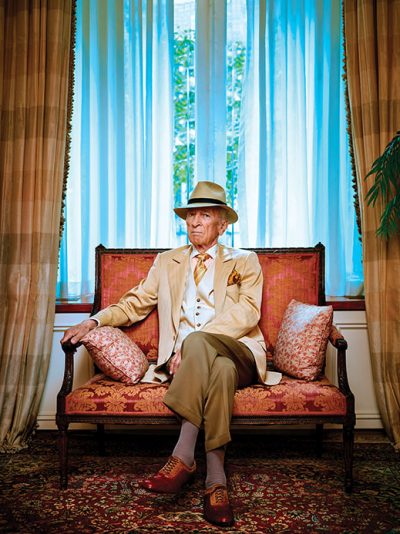
If you think 2016 has been a rough year for Gay Talese, you’re forgetting how 1981 went for the acclaimed writer.
But he remembers it well.
“When Thy Neighbor’s Wife was published in 1981, even the Ocean City Ledger wrote an editorial against it. And I was once a star schoolboy reporter in Ocean City,” says Talese, 84, from his stately, book-lined home on Manhattan’s tony Upper East Side. “It was embarrassing. The reception to that book was terribly ugly.”
The reception to The Voyeur’s Motel, his latest investigative work—about a lascivious, 1970s-era oddball who operated a motel in Colorado where he spied on thousands of unknowing guests as they had sex, fought, did drugs and watched TV—has not been much prettier. And last April, before the release of The Voyeur’s Motel, the Ocean City native suffered a Twitter thrashing as a sexist over his answer to a question at a writing conference at Boston University. Asked which women writers have inspired him, he named Mary McCarthy, a novelist, then added, “…of my generation [pause] um, none.” He later clarified that he meant there were no women in journalism back then who had inspired him, but he was already Twitter toast.
If Talese is still drawing fire well into his ninth decade—more on that to come—he is no less wedded to the work that earned him the title of founding father of New Journalism. He is currently writing a book about his ongoing, 56-year marriage to the editor and publisher Nan Talese, tentatively titled A Nonfiction Marriage. In January, Bloomsbury will publish a new collection of his nonfiction articles, High Notes.
The first story in High Notes, and among those he finds most meaningful, is “Wartime Sunday,” about his New Jersey childhood.
“I didn’t select the pieces, but when I read the selection, I was very pleased, and also surprised,” says Talese on an October morning just before he is due at a photo shoot for Esquire magazine. Talese contributed to Esquire regularly in the 1960s, but the current appointment has more to do with his well-known sense of style; it’s a fashion shoot, for which Talese will venture into the streets of Manhattan in his signature fedora and three-piece, meticulously tailored suit. It’s a look he has been sporting since his New Jersey childhood, enforced by his Italian tailor father.
“When you’ve written for the number of years I have, and you read these pieces sometimes more than half a century later, some of them you don’t quite remember, even though I know I wrote them,” he says. “Reading them now, I can be more of a judge. Including the piece about me as a young man in New Jersey I thought was a wonderful choice, because it was so personal.”
A synopsis in his own words of the 1987 story, which first appeared in Esquire: “It was a piece that drew me back to a sad time in my life during World War II, when I was 10 or 11, which was for me a very complicated and dark period as the son of an Italian father whose own brothers were in the Mussolini army in the 1940s.”
The story dips into that melancholy after an opening anecdote about an embarrassing episode during his stint as an Ocean City altar boy. But its sadness is quickly tempered by youthful remembrances of the mid-1940s, when the New York Yankees trained in Atlantic City and he was able to take a trolley from Ocean City after school to watch them. As befits the collection’s title, “Wartime Sunday” ends on a high note: Talese, his parents and younger sister drive in the family Buick from Ocean City “over the marshlands, past the pine trees, beyond the frosted farmlands and country roads that barely reflected the blue-tinted headlights of our car,” until they finally reach “the circular boulevard with its central granite monument that marked the entrance, away from the coast, into Atlantic City.” There, during dinner in the Italian neighborhood at Venice Restaurant, Talese is admonished by his father for eating his spaghetti incorrectly, with a fork and a spoon, in the manner of cafoni, or country bumpkins. Then Talese notices a young soldier in the restaurant who is surrounded by a lot of people. He is also eating spaghetti the wrong way. That soldier? Joe DiMaggio.
Talese, perhaps still best appreciated for his 1966 Esquire story “Frank Sinatra Has a Cold,” which many consider the best magazine story ever written for its closely observed, fiction-like narrative style, may be more frequently associated with New York and Italy than with New Jersey. New York because he spent much of his writing career there, at publications including the New York Times and the New Yorker, and Italy because of his 1992 memoir Unto the Sons, which traces his family through several generations in Maida, Italy. But his roots are sturdy here. After his “schoolboy reporter” days at Ocean City High, and after college at the University of Alabama, he bought a Victorian house in Ocean City, on east Atlantic Boulevard, in 1966 and maintained it until 2012, mostly spending winters writing on its third floor. The cover illustration of High Notes portrays Talese standing in the Ocean City sand, right hand on hip, in his three-piece suit and fedora.
“My parents lived a two-minute bike ride away, toward Longport,” he says. His father died in 1993 at 89; when his mother died in 2006, in the last year of her 90s, “I had no real reason to stay,” he says.
“It was a beautiful, rambling, three-story house, and there was nothing intruding over it because it bordered the Atlantic shoreline. I had skylights on the third floor, and you could see well into the sky. The light came through the skylights, and you felt vividly connected to the outdoors. You could feel it in your brain. I was very influenced by the atmosphere there, in Ocean City. It was cheerful, bright and open,” he says.
Now, when not in Manhattan, he and Nan live in Connecticut, “in Roxbury—a literary community,” he says, noting a neighbor is the editor of Vanity Fair. Nan bought the house in 2012 without telling him; their two daughters, Pamela and Catherine, are grown.
He doesn’t like to write in the new house.
“There are too many damn trees,” he says. They block the natural light.
He is also less likely to enjoy the solitude of writing at his stately, antique-filled Manhattan residence, where he currently works below the first floor in what he calls “the bunker.”
“I’m in the darkness under the ground,” he says, spending most days researching and cataloging his correspondence with Nan for A Nonfiction Marriage with the help of an assistant from NYU. He hopes to finish writing that book, which is under contract with Knopf, this spring. “It’s not very cheerful down there.”
Has it affected his work?
“I’m not sure it’s affected my work,” he says, “but it might affect my personality.”
If his surroundings affect Talese’s personality, controversy and condemnation seem not to.
“When you’re battle scarred like I am, and you have a lot of experience being kicked around, the stuff you’re talking about is small,” he says, referring to his rough year. First, there was the outrage over his difficulty coming up with women writers who inspired him and then the charges that The Voyeur’s Motel is a sleazy book with a perverted main character unworthy of Talese’s literary talent.
If the criticisms were meant to sting, the stings didn’t penetrate. “It doesn’t make any difference to me,” Talese says. “I expect it; the great writers have the most criticism.”
“It was much worse back then,” he says, referring to the 1980s, when Thy Neighbor’s Wife was making the rounds. “That book was considered obscene by many people. And it was much more reviewed. But this latest thing is sort of connected.”
The link is Talese’s stubborn curiosity which, in both books, ends up coming across to some as fearless human-nature cataloging, and to others as lewd sensationalism.
Thy Neighbor’s Wife documented an affair Talese had in the late 1970s, when his marriage to Nan was already well underway, as well as his experiences managing massage parlors in New York and hanging out at a nude beach near Ocean City, among other activities often seen as morally questionable. His goal was to understand American sexual mores in the last days of the sexual revolution. But feminists, anti-porn activists and some critics doubted his intentions.
The attention he pays in The Voyeur’s Motel to Gerald Foos, the creepy hotel operator who spied on guests using an “observation platform” outfitted with customized-phony ceiling vents, has been similarly maligned.
But there was a difference this time, in that Talese was also taken to task for collaborating with Foos, who turned out to be unreliable in reporting his adventures in peeping. While most of the narrative in The Voyeur’s Motel takes place before 1980, one voyeuristic scene occurs between 1980 and 1988, when Foos had already sold the motel. Talese didn’t know about the sale until the Washington Post uncovered it. The revelation cast doubt on some of the recollections Foos shared with Talese.
Nonetheless, Talese hasn’t disavowed the book. And neither has David Remnick, the editor of the New Yorker, who has stood by it since excerpting it in the magazine last spring before publication.
In an e-mail to the New York Times last summer, Remnick wrote: “The central fact of the piece, that Gerald Foos was, in the late ’60s and ’70s, a voyeur, spying on the guests in his motel, is not in doubt in the article. The fact that he could sometimes prove an unreliable and inaccurate narrator is also something that Gay Talese makes clear to the reader, repeatedly, and is part of the way Foos is characterized throughout the article.”
Talese says if there are details to correct in later editions, “we’ll do that.”
What he will not do, he says, is stop drilling deep into the stories that fascinate him, even when they involve spilling the details of his own marriage—a subject he knows will court still more controversy—or cooperating with loathsome types like Foos. “My ambition as a nonfiction writer is to move into an area that nonfiction writers don’t usually move into—private life. In A Nonfiction Marriage, I’m naming me and I’m naming my wife; it’s not made up.
“I haven’t changed much. I’m an old guy doing the same things I did as a young guy in New Jersey,” he says. “Foos is a typical character for me. I’ve often written about ordinary people and disreputable people.”
Sometimes, though, his subjects are shinier. Dazzling, even.
Frank Sinatra, for example.
“He was never a loser,” Talese says. “He was always glamorous.”
Some might argue otherwise, but at least one of the characters he’s investigating for A Nonfiction Marriage also fits that category: Gay Talese himself.
Tammy La Gorce is a frequent contributor.
